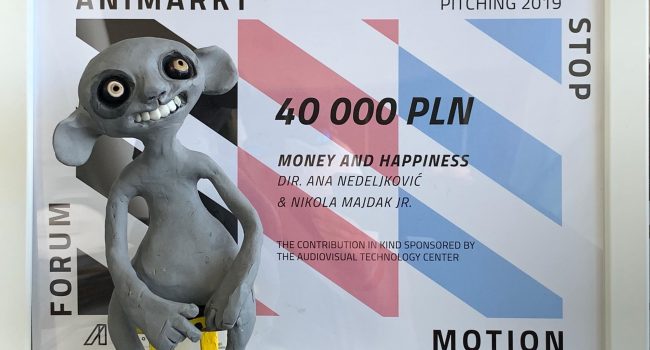Ana Nedeljkovic and Nikola Majdak, Jr. received the award for their new animated short film Money and Happiness at Animarkt Pitching in Poland. The prize amounts to 40,000 zlotys for the production of the film at the CeTa studious in Wroclaw and, in fact, it is one of the two main awards of this market.

It is a 9-minute stop-motion film, produced by Jelena Mitrović and Belgrade-based production company Bas Celik, with the support of the Film Center Serbia (FCS).
SYNOPSIS: Hamsters live and work hard in Hamsterland, a perfect country with a perfect economy. GDP is constantly rising, there is no unemployment, and 100% of the population consider themselves happy. Of course, like any attempt to forcibly a perfect society, the world of the Hamsters has its dark side, which we gradually discover throughout the film.

The author’s explication, however, reveals this: “For a growing number of people, it is more than obvious that today’s dominant concept of an economy where money is the main goal is not sustainable. An economy that measures its success with GDP is often insensitive to the real happiness and well-being of the population.
Learning about the basics of theories that consider the primary goal of economics to be a contribution to the common good, and money only as a means to that end, the initial idea for the film came up. What particularly interested us was the need to establish a clear and, above all, measurable link between economic parameters and the well-being and happiness of the population. Although very positively oriented towards this idea, according to our aesthetics and approach to animation, we saw the greatest creative potential in intensifying and symbolically presenting the negative elements of today’s economic systems. We decided to create an ironic model of an ideal economy. It is a world of Hamsters who live and work hard in a giant office-state. GDP is constantly rising, there is no unemployment, and 100% of the population declare themselves to be happy. Of course, just like any attempt to forcibly create a perfect society (in which the value of anything is 100%), Hamsterland also has its dark side, which we gradually discover throughout the film.
Hamsters, as proven obedient laboratory animals, were a logical choice for participants in this experiment. On the other hand, behind the choice of this complex topic is strong personal motivation, an attempt to cope with the traumas of life in a closed circle of everyday life, consisting of making and spending money, but also the constant fear of losing money and sliding into poverty. Although conscious of the absurdity of this process, the fetishisation of money and the misuse of labor, in real life, it seems as if we are constantly falling into the same pitfalls, agreeing to play the roles of of Hamsters in Hamsterland.”

Ana Nedeljkovic and Nikola Majdak, Jr. are authors of two very notable short animated films – Rabbitland and Untravel. Rabbitland (2013) was awarded the Crystal Bear Award at the Berlinale and has been shown at more than one hundred festivals across the globe, winning other significant awards.Untravel premiered in Berlin at the 2018 Berlin Film Festival and won the Grand Prix in the animated film category at the March Festival. The film directly qualified for the Oscars based on the Golden Pegasus Grand Prix at the Animator Festival in Poland, and was also nominated for the prestigious Annie Award in Los Angeles. The film has been screened at numerous other festivals so far.

